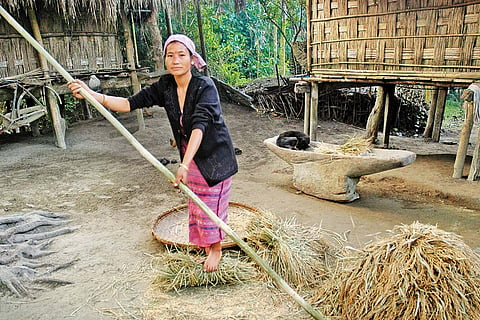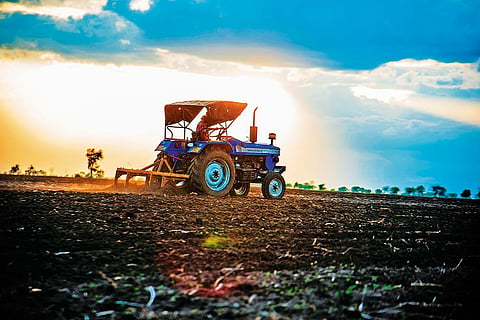There is no one way to describe changes in the state of farming and farmers over the past seven decades. Optimists contend that farm production is now at a stratospheric height, and India, which was a food importer, is self-sufficient and counted among the top 10 exporters in the world. Millions of farmers are out of poverty due to the pull-effect. Apart from wheat and rice, they now grow cash crops, and have diversified into horticulture and dairy. According to the pessimists, however, agriculture remains at the mercy of the monsoons, as climate change wreaks more havoc. Production is highly inconsistent, with a series of gluts and droughts. A majority of farmers own miniscule land—they cannot feed their families, and are deeply indebted and exploited by middlemen. They continue to starve, and many commit suicide. The ongoing farmers’ protest is a loud indicator of their abysmal living conditions.
Independence Didn’t Free India Farmers From Cycle Of Debt And Deaths
For the majority of farmers, growing the -country’s food brings no -assurance of well-being. Seven decades after -independence, swings between glut and scarcity remain largely unpredictable, making agriculture unviable for greater numbers.
And then there are the centrists, who see shades of good and bad. “The health of farming has improved, but not the financial health and well-being of farmers,” laments Pranab Singh, president, National Academy of Agricultural Sciences. “We cannot say the producers can be counted among the well-off.” Others feel the -opposite: the living standards of farmers are better, but agriculture remains under severe stress due to inherent and external factors.
Seen through differing contexts and perspectives, all the above conclusions are not completely true—and partly false. Let us first look at the condition of farm producers. Among the urban elite, and the middling middle class, there are thousands who took voluntary retirement from corporate jobs and opted for agriculture. Some of the mandatorily retired people did the same. There are others who desire to leave the ‘rat race’ and go back to their roots, their villages.
Gauri Shankar, a Ghaziabad-based manager in an online pharmacy, works the fields on weekends. On weekdays, he is up at 4am, attends to farm-related chores and gets on with office work. “For generations, we have been a family of farmers. Some are educated with urban jobs, but most work in the farms. As the extended family is -involved, it is easier and augments -incomes,” he says, even as he struggles to get compensation for a part of his land acquired by the government.

An Assamese tribal woman threshing paddy
After he retired as a scientist from ICAR-IARI, V.S. Lather has been -devoting his energies to enhance the productivity of his family’s land in Karnal, using his earlier research on direct-seeded rice. He proudly claims that he was the only one among 16 cousins to land a corporate job. But now, he too tills the land. Rapid urbanisation lured the family to sell their lands in the city. The surplus money, however, was invested in buying cheaper farms in the nearby villages.
Rich farmers in states such as Chhattisgarh, Punjab, Gujarat and Kerala benefit from schemes like -minimum support price (MSP). They have access to mechanised equipment, high-quality seeds and cheap agri-chemicals, and use other technology and research interventions. Their large tracts -enable them to hire -migrant labour, as is the case with the apple orchards of Himachal Pradesh and Kashmir, and the plantations in south India. They -manage to -ring-fence their earnings.
The smart ones get into highly profitable niche areas like organic farming and cash crops. They join hands with large companies, which buy the -produce at pre-decided prices, and supply the growers with critical inputs and funds. This tendency will grow with the new farm acts, which include laws for corporate and lease farming. Collectives like cooperatives and Farmer Producer Organisations (FPOs) allow such farmers to tap new domestic and export markets.
ALSO READ: When Liberalisation Freed India Inc
Unfortunately, the causes, reasons and trends that affected certain sections in positive ways had the opposite impact on other segments. The -increase in family members over generations fractured and fragmented landholdings. Most landowners are now small and marginal. At present, 85 per cent possess less than two hectares each, which is neither sustainable nor viable. They are unable to use high-quality inputs or technology tools. Their productivity is abysmal.
For these croppers, government schemes are either out of reach or come with obstacles. They are expected to pay the market prices for fertilisers, and then wait weeks and months for the transfer of the subsidies into their bank -accounts, i.e. if they have one and know how to operate them. They dep-end on the monsoons for their survi-val, and their lives are continuously wrecked by either lack of water, or too much of it. Basic amenities like potable water and electricity elude them.

Middlemen and rural elites ensure small farmers are forced to sell their produce 20-30 per cent below the MSP. As the latter don’t have the resources to reach the markets, they sell the crops at huge discounts during periods of -oversupply. During shortages, they are so distressed due to dismal production that they invariably settle for lower-than-market prices. In both situations, they lose and are unable to survive decently throughout their lives.
In many instances, both private parties and state governments pressure the marginal producers to sell their land for infrastructure projects and large factories at rock-bottom prices. When they are compensated well, they squander the money in the acquisition of assets like cars and home appliances, gambling and alcohol. The end result in both situations: future generations stay away from farming, and migrate to the cities in search of better alternatives.
Corporate farming turns out to be a double-edged sword. The companies -become the new exploiters who twist the arms of farmers. As the croppers become more dependent on the powerful entities for their needs, the latter use their clout to treat the landowners as their modern-day slaves. In some cases, the farmers end up losing their farms. The executive and the judiciary tend to side with the companies, which can fight legal cases for years. In the end, the poor give up.
Let us turn to the state of agriculture. The past seven decades can be roughly -divided into three broad phases: pre-Green Revolution (1950s-60s), Green Revolution (1960s-80s), and post-Green Revolution (1990s and after). Each one was triggered by unique challenges, which spurred new changes that led to -immediate gains and long-term shocks. The impacted sections tell the narratives based on what happened to them, and around them.

In the beginning came acute food shortages, which forced the country to -depend on subsidised imports, especially under the PL-480 scheme of the US. Hence, the focus was on ‘grow more food’ campaigns, which led to experiments in rain-intensive cultivation. It started in Aligarh, and spread to other districts. However, two major droughts in the 1960s shattered the faith in these initiatives. Policymakers and experts felt this was the time to shift farm gears.
The Green Revolution was the new solution. When it started with the introduction of the Mexican wheat variety, it was a ‘brave gamble’. No one knew if the -hybrid seeds that promised higher productivity would work. “M.S. Swaminathan and Norman Borlaugh (the two champions) took the risks with the backing of the political leadership. It raised production levels,” remembers Y.K. Alagh, an agriculture expert. It changed the contours of the countryside in Punjab and Haryana.
Over the next few decades, the successes of the Green Revolution (in production of wheat and rice) pushed the Centre to adopt similar strategies for other crops and areas such as pulses, dairy, oilseeds, poultry and horticulture. These -included the White Revolution (milk and dairy) in Gujarat, millets in southern states, aquaculture in Andhra Pradesh and Jharkhand, and horticulture in Uttar Pradesh and Maharashtra. The moves transformed the traditional cropping patterns among farmers.
Former planning commission member Abhijit Sen says India’s -agriculture performance was “better than what I expected in the early 1970s (at the peak of Green Revolution)”. “I did not think that technology would work so well in the fields such as weather forecast, imp-rovements in crop varieties, and transfer of research from the labs to farms,” he recalls. Unexpectedly, for short and medium periods, and with varying gains in economic terms, they benefited certain sections of farmers.

Most triumphs, however, lead to -colossal failures. “In the attempts to improve productivity through the use of chemical fertilisers and pesticides (apart from seed varieties), both the planners and growers overlooked the impact on the environment. This led to soil damage and groundwater contamination,” explains Sudhir Panwar, -former member of the Uttar Pradesh planning commission, who was closely attached to his family’s farming activities during his professional career.
Productivity slumped in the late 1970s and ’80s in the original Green Revolution belt of Punjab and Haryana. Some experts contend that this aided the rise of terrorism, as rural Punjab faced the scare of dwindling inc-omes and -unemployment, even as the cities were unable to provide jobs to the -now-educated migrants. Over the next few decades, the scenario slipped into -heroin addiction among the rural and urban youth. Two or three generations were wasted and washed out.
When India entered an era of reforms, the focus was on the transfer of resea-rch learning from the labs to the fields. T. Mohapatra, DG, ICAR, says technology adoption played a significant role in making India a food-surplus nation. Digital tools and platforms enabled the dissemination of information to farmers. Krishi Vigyan Kendras, which reached out to 10 million growers six years ago, have enhanced this figure by six times. Rural India took giant strides to enter this century.
“There are micro indicators to show how the emerging technologies and -research reached out to the farms. This is evident from the high farm production in the recent past, despite Covid and the fact that the area under cultivation came down drastically,” adds Mohapatra. It is obvious that productivity levels are up. Other indicators lead us to similar conclusions. The -annual foodgrain production zipped six times to more than 300 million tonnes between 1950-51 and 2020-21.
At present, India produces 25 per cent of the world’s pulses, and ranks second in crops such as rice, wheat, cotton, groundnut, and fruits and -vegetables. It is the largest producer of sugarcane (4 per cent annual growth) and milk (5 per cent). At 320 million tones, the annual fruits and vegetables production is higher than the figure for foodgrains. Fisheries, which registered an average annual growth of 6 per cent over the past decade, earn $7 billion a year through exports.
“Government incentives, which were backed by research, doubled fisheries -production to 14 million tonnes in the past decade. Our target is to raise it to 25 million tonnes in the next few years. States such as Chhattisgarh, Jharkhand, Haryana, Punjab, Andhra Pradesh, Kerala and West Bengal took the lead. In -exports, the focus is on shrimps and seaweeds. India is the -second-largest global producer of fish, after China,” says W.S. Lakra, Nabard chair of CMFRI.
ALSO READ: The Healthy Paranoia
Juxtapose these numbers with the deep downsides. “Over the past seven decades, the yearly -agriculture performance hovered -between 2.5 per cent and 3 per cent. The desi-red growth for a fast-growing nation is a minimum 4 per cent,” says Alagh. “Annual growth witnessed spikes and spurts, as well as periods of stagnation.” There were several years of negative growth too. This inconsistency is frightening, as the farmers are never sure about what is likely to -happen the next season.
Every year, the country wastes 15 per cent of foodgrains and 30 per cent of perishables due to the lack of short-term storages and long-term cold -storages. The government -warehouses are a joke, and there is a huge shortage in the private sector. The scenario is the same in the case of related areas such as poultry, dairy and animal husbandry. The overall failure of the food processing sector complicates the issues. Most farmers lack the resources, knowledge and access to technology.
“Three decades ago, there were minimal concerns over climate change and its consequences on the weather patterns. These are now stark and clear,” says Sen. The changes have, and will continue to have, a huge impact on agriculture, which will become more volatile in the near future. He adds that we need a vision to -improve weather predictions, watershed management and irrigation, along with greater diversification and efficient cropping patterns.
For small and marginal farmers, it is a tough journey, as it was 74 years ago. Things changed, but the core issues that cause distress and shackle them to -poverty remain the same. Farming remains unviable for most families. Different policies to shore up incomes have not worked perfectly; they were misused and abused by vested interests. “I am smart and educated. Yet, I barely manage to break even. Imagine the state of the poor,” says an urban farmer.
So, the next time you get this urge to leave everything, quit the city, use savings to buy land in a remote area, and become a happy, content and comfortable farmer, think again. It is an idyllic idea seeped in social romance, but the challenges are huge, even if you are better off than the poor croppers. You will not starve to death like many of them, or be squeezed out of the last penny by the local moneylender or the bank. However, you will be lucky to earn profits.
(This appeared in the print edition as "Bitter Harvest")
ALSO READ